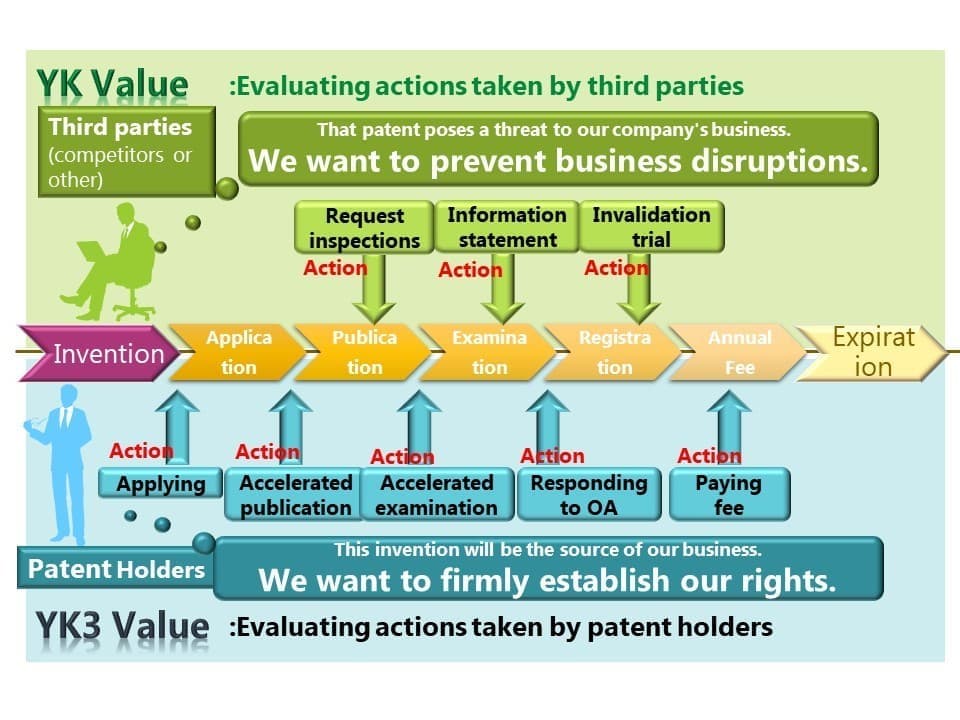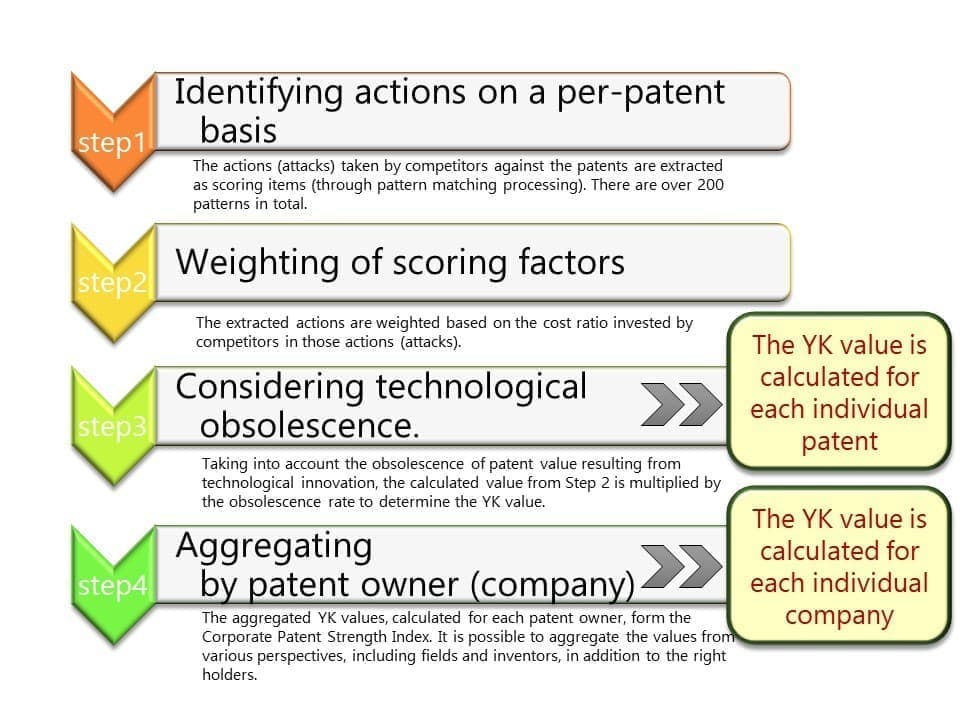Introduction to the YKS method(YK Value)
Valuation
We provide valuation services for intellectual property rights.
In recent years, the proportion of intangible assets within the market capitalization of companies has been increasing significantly, and it is no exaggeration to say that it is an era where the strength of intangible assets determines success or failure. In order to effectively utilize intangible assets, it is necessary to accurately evaluate their value. Without the ability to accurately evaluate intangible assets, efficient investments and M&A activities cannot be conducted, and asset management becomes challenging. This not only affects the competitiveness of individual companies but also has the potential to weaken the overall competitiveness of the Japanese economy.
Therefore, our firm has developed proprietary evaluation methodologies for patent rights, namely
The YKS method evaluates the earning power of patent portfolios, while the PQ method assesses the monetary value of patent rights. Furthermore, on this website, we provide
corporate patent evaluation indices
utilizing the YKS method.
The YKS method evaluates the earning power of patent portfolios, while the PQ method assesses the monetary value of patent rights. Furthermore, on this website, we provide corporate patent evaluation indices utilizing the YKS method
What is the YKS method?
The YKS method is a technique developed by Kudo&Associates to measure the value of patents.
Because,
Therefore, the YKS Method was developed with the idea of analyzing and aggregating various data disclosed by the patent office to score the value of each patent as accurately as possible. The goal was to determine if it is possible to score the value of patents in a precise manner.
The YKS Method includes the following:
- ◆ Patent Technological Competitiveness Index (YK value)
- ◆ Patent Investment Intensity Index (YK3 value)
By utilizing these indices individually or in combination, and by aggregating them for each company, various analyses become possible.

Regarding the YKS Method, we have obtained the patent rights.
Please refer to this page and the patent publication (Patent No. 5273840)
What is the YK value?
The YK value is a measure of the strength of patent exclusivity.
Patent Exclusivity
When an invention is filed and granted as a patent, the patent holder obtains the exclusive right to practice the invention.
In other words, others are prohibited from using the invention without the consent of the patent holder. This is the 'exclusivity' granted by a patent (Article 68 of the Patent Law).
Measurement of Patent Exclusivity Strength
For competing companies, patents with strong 'exclusivity' pose a threat. The higher the risk of their business activities being restricted, the more they are willing to invest in investigating and potentially invalidating such patents. In other words, patents that face more interference or attacks from third parties have stronger 'exclusivity' and are considered valuable assets in business terms.
Hence, by calculating the costs incurred from actions taken by these third parties, it becomes possible to measure the level of exclusivity of a patent and quantify its value. This concept gave rise to the YK value (Patent Technological Competitiveness Index).


What is the YK3 value?
The YK3 value is a measure of the level of focus or attention given by the patent holder to their patent.
Differences in Perspective between YK Value and YK3 Value
While the YK value measures the value of a patent from the perspective of third parties, such as competing companies, the YK3 value is a measure of the value of the patent from the perspective of the patent holder themselves.
Measurement of Value from the Patent Holder's Perspective
Patent holders take various actions concerning their patents, such as:
- ・ Filing inventions for patent protection.
・ Requesting early publication from the patent office to expedite the disclosure.
・ Paying maintenance fees to keep the patent in force.
By extracting and evaluating the costs associated with these actions (referred to as 'actions' here), it is believed that the level of value the patent holder assigns to their patent can be measured. This concept gave rise to the YK3 value (Patent Investment Intensity Index).
From a cost-based perspective, the YK3 value can be seen as complementing the YK value, fulfilling a complementary role in assessing the value of the patent from the patent holder's standpoint.
Characteristics of the YKS Method
The following characteristics can be highlighted:
- Evaluation of the Economic Value of Patents: The YKS method evaluates the value of patents not solely from a technological standpoint, such as their technical sophistication, but also from a business perspective, considering their economic value.
- Based Solely on Patent Information: The YKS method relies exclusively on patent information and does not incorporate financial data. It involves analyzing patent information to provide a new perspective and insights that cannot be derived from financial information.
- Evaluation Based on Detailed Data for Each Patent: The method assesses each patent by extracting and aggregating third-party actions (in the case of YK value) or actions by the patent holder (in the case of YK3 value) for individual patents. This enables a meticulous evaluation of each patent.
- Objective Numerical Analysis with Software: The method utilizes software to analyze patent data issued by patent offices, ensuring objective evaluations that are not influenced by subjectivity.
- Cost-Effective Evaluation of Patent Portfolios: Since the calculations are performed using computer algorithms, the YKS method is generally cost-effective.
- Utilization Scenarios for the YKS Method*
- Evaluation of a Company's Competitiveness from the Perspective of Patent Strength
- Selection of Companies with Strong Patents for M&A Opportunities
- Supporting Investment and Loan Decision-Making
- Analysis of Patent Share among Companies in Specific Technology Fields
- Analysis and Improvement of Corporate Patent Strategies
These are just a few examples of the various scenarios where the YKS method can be applied.
Calculation Flow of YK Value and YK3 Value
The calculation of YK value and YK3 value is generally performed following the steps outlined below.

The Image of the Calculation Process
What is the YKS Technology Industry Classification?
In our firm, we developed the world's first technology industry classification based on technology and technical information, known as the YKS Technology Industry Classification (abbreviated as YKS Classification), in May 2013.
This classification is designed to facilitate understanding of the industrial structure and provide insights into the business of each company.
- (as of April 30th 2024)
- YKS Classification List
- (For YKS Map of Patent Strength Industry (with explanations)
、as of April 1st 2024)
Other Methods
PQ Method
The PQ method overcomes the limitations of monetary evaluation of patents. It ensures objectivity without relying on the concept of patent contribution rates. Additionally, it calculates patent-specific risks based on objective data.
TK Method
Information on the TK method will be available soon.


